共享模型之无锁
管程即monitor是阻塞式的悲观锁实现并发控制,这章我们将通过非阻塞式的乐观锁的来实现并发控制
6.1 问题提出
有如下需求,保证account.withdraw取款方法的线程安全 Test5.java
public class Test5 {public static void main(String[] args) {Account.demo(new AccountUnsafe(10000));}}class AccountUnsafe implements Account {private Integer balance;public AccountUnsafe(Integer balance) {this.balance = balance;}@Overridepublic Integer getBalance() {return balance;}@Overridepublic void withdraw(Integer amount) {// 通过这里加锁就可以实现线程安全,不加就会导致结果异常synchronized (this){balance -= amount;}}}interface Account {// 获取余额Integer getBalance();// 取款void withdraw(Integer amount);/*** 方法内会启动 1000 个线程,每个线程做 -10 元 的操作* 如果初始余额为 10000 那么正确的结果应当是 0*/static void demo(Account account) {List<Thread> ts = new ArrayList<>();long start = System.nanoTime();for (int i = 0; i < 1000; i++) {ts.add(new Thread(() -> {account.withdraw(10);}));}ts.forEach(Thread::start);ts.forEach(t -> {try {t.join();} catch (InterruptedException e) {e.printStackTrace();}});long end = System.nanoTime();System.out.println(account.getBalance()+ " cost: " + (end-start)/1000_000 + " ms");}}
解决思路-无锁
上面的代码中可以使用synchronized加锁操作来实现线程安全,但是synchronized加锁操作太耗费资源,这里我们使用无锁来解决此问题: Test5.java
class AccountSafe implements Account{
AtomicInteger atomicInteger ;
public AccountSafe(Integer balance){
this.atomicInteger = new AtomicInteger(balance);
}
@Override
public Integer getBalance() {
return atomicInteger.get();
}
@Override
public void withdraw(Integer amount) {
// 核心代码
while (true){
int pre = getBalance();
int next = pre - amount;
if (atomicInteger.compareAndSet(pre,next)){
break;
}
}
// 可以简化为下面的方法
// balance.addAndGet(-1 * amount);
}
}
6.2 CAS 与 volatile
cas
前面看到的AtomicInteger的解决方法,内部并没有用锁来保护共享变量的线程安全。那么它是如何实现的呢?
@Override
public void withdraw(Integer amount) {
// 核心代码
// 需要不断尝试,直到成功为止
while (true){
// 比如拿到了旧值 1000
int pre = getBalance();
// 在这个基础上 1000-10 = 990
int next = pre - amount;
/*
compareAndSet 正是做这个检查,在 set 前,先比较 prev 与当前值
- 不一致了,next 作废,返回 false 表示失败
比如,别的线程已经做了减法,当前值已经被减成了 990
那么本线程的这次 990 就作废了,进入 while 下次循环重试
- 一致,以 next 设置为新值,返回 true 表示成功
*/
if (atomicInteger.compareAndSet(pre,next)){
break;
}
}
}
其中的关键是 compareAndSet,它的简称就是 CAS (也有 Compare And Swap 的说法),它必须是原子操作。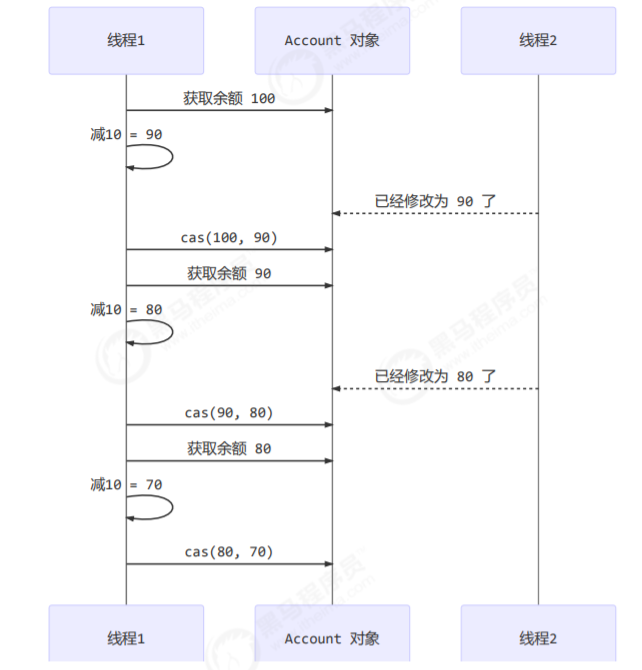
volatile
在上面代码中的AtomicInteger,保存值的value属性使用了volatile 。获取共享变量时,为了保证该变量的可见性,需要使用 volatile 修饰。
它可以用来修饰成员变量和静态成员变量,他可以避免线程从自己的工作缓存中查找变量的值,必须到主存中获取 它的值,线程操作 volatile 变量都是直接操作主存。即一个线程对 volatile 变量的修改,对另一个线程可见。
再提一嘴 volatile 仅仅保证了共享变量的可见性,让其它线程能够看到最新值,但不能解决指令交错问题(不能保证原 子性)
CAS 必须借助 volatile 才能读取到共享变量的最新值来实现【比较并交换】的效果
为什么无锁效率高
- 无锁情况下,即使重试失败,线程始终在高速运行,没有停歇,而 synchronized 会让线程在没有获得锁的时候,发生上下文切换,进入阻塞。打个比喻:线程就好像高速跑道上的赛车,高速运行时,速度超快,一旦发生上下文切换,就好比赛车要减速、熄火,等被唤醒又得重新打火、启动、加速… 恢复到高速运行,代价比较大
但无锁情况下,因为线程要保持运行,需要额外 CPU 的支持,CPU 在这里就好比高速跑道,没有额外的跑道,线程想高速运行也无从谈起,虽然不会进入阻塞,但由于没有分到时间片,仍然会进入可运行状态,还是会导致上下文切换。
CAS 的特点
结合 CAS 和 volatile 可以实现无锁并发,适用于线程数少、多核 CPU 的场景下。
CAS 是基于乐观锁的思想:最乐观的估计,不怕别的线程来修改共享变量,就算改了也没关系,我吃亏点再重试呗。
- synchronized 是基于悲观锁的思想:最悲观的估计,得防着其它线程来修改共享变量,我上了锁你们都别想改,我改完了解开锁,你们才有机会。
CAS 体现的是无锁并发、无阻塞并发,请仔细体会这两句话的意思
使用原子的方式更新基本类型上面三个类提供的方法几乎相同,所以我们将以 AtomicInteger 为例子来介绍。
- AtomicInteger:整型原子类
- AtomicLong:长整型原子类
- AtomicBoolean :布尔型原子类
- 原子引用
- 原子数组
- 字段更新器
- 原子累加器
下面先讨论原子整数类,以 AtomicInteger 为例讨论它的api接口:通过观察源码可以发现,AtomicInteger 内部都是通过cas的原理来实现的!!好像发现了新大陆! Test6.java
public static void main(String[] args) {
AtomicInteger i = new AtomicInteger(0);
// 获取并自增(i = 0, 结果 i = 1, 返回 0),类似于 i++
System.out.println(i.getAndIncrement());
// 自增并获取(i = 1, 结果 i = 2, 返回 2),类似于 ++i
System.out.println(i.incrementAndGet());
// 自减并获取(i = 2, 结果 i = 1, 返回 1),类似于 --i
System.out.println(i.decrementAndGet());
// 获取并自减(i = 1, 结果 i = 0, 返回 1),类似于 i--
System.out.println(i.getAndDecrement());
// 获取并加值(i = 0, 结果 i = 5, 返回 0)
System.out.println(i.getAndAdd(5));
// 加值并获取(i = 5, 结果 i = 0, 返回 0)
System.out.println(i.addAndGet(-5));
// 获取并更新(i = 0, p 为 i 的当前值, 结果 i = -2, 返回 0)
// 函数式编程接口,其中函数中的操作能保证原子,但函数需要无副作用
System.out.println(i.getAndUpdate(p -> p - 2));
// 更新并获取(i = -2, p 为 i 的当前值, 结果 i = 0, 返回 0)
// 函数式编程接口,其中函数中的操作能保证原子,但函数需要无副作用
System.out.println(i.updateAndGet(p -> p + 2));
// 获取并计算(i = 0, p 为 i 的当前值, x 为参数1, 结果 i = 10, 返回 0)
// 函数式编程接口,其中函数中的操作能保证原子,但函数需要无副作用
// getAndUpdate 如果在 lambda 中引用了外部的局部变量,要保证该局部变量是 final 的
// getAndAccumulate 可以通过 参数1 来引用外部的局部变量,但因为其不在 lambda 中因此不必是 final
System.out.println(i.getAndAccumulate(10, (p, x) -> p + x));
// 计算并获取(i = 10, p 为 i 的当前值, x 为参数1值, 结果 i = 0, 返回 0)
// 函数式编程接口,其中函数中的操作能保证原子,但函数需要无副作用
System.out.println(i.accumulateAndGet(-10, (p, x) -> p + x));
}
6.4 原子引用
为什么需要原子引用类型?保证引用类型的共享变量是线程安全的(确保这个原子引用没有引用过别人)。
基本类型原子类只能更新一个变量,如果需要原子更新多个变量,需要使用引用类型原子类。
- AtomicReference:引用类型原子类
- AtomicStampedReference:原子更新带有版本号的引用类型。该类将整数值与引用关联起来,可用于解决原子的更新数据和数据的版本号,可以解决使用 CAS 进行原子更新时可能出现的 ABA 问题。
- AtomicMarkableReference :原子更新带有标记的引用类型。该类将 boolean 标记与引用关联起来,
也可以解决使用 CAS 进行原子更新时可能出现的 ABA 问题。
使用原子引用实现BigDecimal存取款的线程安全:Test7.java
下面这个是不安全的实现过程:
class DecimalAccountUnsafe implements DecimalAccount {
BigDecimal balance;
public DecimalAccountUnsafe(BigDecimal balance) {
this.balance = balance;
}
@Override
public BigDecimal getBalance() {
return balance;
}
@Override
public void withdraw(BigDecimal amount) {
BigDecimal balance = this.getBalance();
this.balance = balance.subtract(amount);
}
}
解决代码如下:在AtomicReference类中,存在一个value类型的变量,保存对BigDecimal对象的引用。
class DecimalAccountCas implements DecimalAccount{
//private BigDecimal balance;
private AtomicReference<BigDecimal> balance ;
public DecimalAccountCas(BigDecimal balance) {
this.balance = new AtomicReference<>(balance);
}
@Override
public BigDecimal getBalance() {
return balance.get();
}
@Override
public void withdraw(BigDecimal amount) {
while(true){
BigDecimal pre = balance.get();
// 注意:这里的balance返回的是一个新的对象,即 pre!=next
BigDecimal next = pre.subtract(amount);
if (balance.compareAndSet(pre,next)){
break;
}
}
}
}
ABA 问题及解决
ABA 问题:Test8.java 如下程序所示,虽然再other方法中存在两个线程对共享变量进行了修改,但是修改之后又变成了原值,main线程中对此是不可见得,这种操作这对业务代码并无影响。
static AtomicReference<String> ref = new AtomicReference<>("A");
public static void main(String[] args) throws InterruptedException {
log.debug("main start...");
// 获取值 A
// 这个共享变量被它线程修改
String prev = ref.get();
other();
utils.sleep(1);
// 尝试改为 C
log.debug("change A->C {}", ref.compareAndSet(prev, "C"));
}
private static void other() {
new Thread(() -> {
log.debug("change A->B {}", ref.compareAndSet(ref.get(), "B"));
}, "t1").start();
utils.sleep(1);
new Thread(() -> {
// 注意:如果这里使用 log.debug("change B->A {}", ref.compareAndSet(ref.get(), new String("A")));
// 那么此实验中的 log.debug("change A->C {}", ref.compareAndSet(prev, "C"));
// 打印的就是false, 因为new String("A") 返回的对象的引用和"A"返回的对象的引用时不同的!
log.debug("change B->A {}", ref.compareAndSet(ref.get(), "A"));
}, "t2").start();
}
主线程仅能判断出共享变量的值与最初值 A 是否相同,不能感知到这种从 A 改为 B 又改回 A 的情况,如果主线程希望:只要有其它线程【动过了】共享变量,那么自己的 cas 就算失败,这时,仅比较值是不够的,需要再加一个版本号。使用AtomicStampedReference来解决。
AtomicStampedReference
解决ABA问题 Test9.java
static AtomicStampedReference<String> ref = new AtomicStampedReference<>("A",0);
public static void main(String[] args) throws InterruptedException {
log.debug("main start...");
// 获取值 A
int stamp = ref.getStamp();
log.info("{}",stamp);
String prev = ref.getReference();
other();
utils.sleep(1);
// 尝试改为 C
log.debug("change A->C {}", ref.compareAndSet(prev, "C",stamp,stamp+1));
}
private static void other() {
new Thread(() -> {
int stamp = ref.getStamp();
log.info("{}",stamp);
log.debug("change A->B {}", ref.compareAndSet(ref.getReference(), "B",stamp,stamp+1));
}, "t1").start();
utils.sleep(1);
new Thread(() -> {
int stamp = ref.getStamp();
log.info("{}",stamp);
log.debug("change B->A {}", ref.compareAndSet(ref.getReference(), "A",stamp,stamp+1));
}, "t2").start();
}
AtomicMarkableReference
AtomicStampedReference 可以给原子引用加上版本号,追踪原子引用整个的变化过程,如:A -> B -> A ->C,通过AtomicStampedReference,我们可以知道,引用变量中途被更改了几次。但是有时候,并不关心引用变量更改了几次,只是单纯的关心是否更改过,所以就有了AtomicMarkableReference Test10.java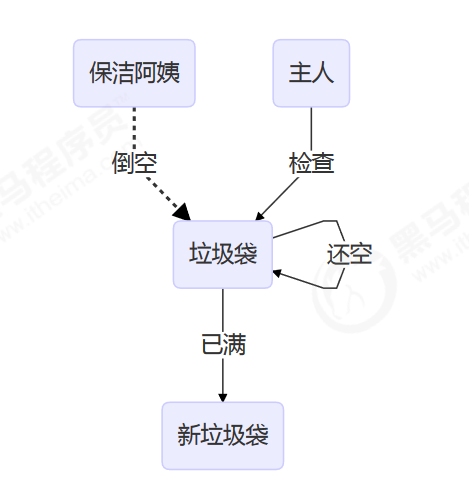
6.5 原子数组
使用原子的方式更新数组里的某个元素
- AtomicIntegerArray:整形数组原子类
- AtomicLongArray:长整形数组原子类
- AtomicReferenceArray :引用类型数组原子类
上面三个类提供的方法几乎相同,所以我们这里以 AtomicIntegerArray 为例子来介绍。实例代码:Test11.java
我们将使用函数式编程来实现,先看看一些函数式编程的接口的javadoc文档
Represents a supplier of results.
表示supplier的结果。
There is no requirement that a new or distinct result be returned each time the supplier is invoked.
不要求每次调用供应商时都返回一个新的或不同的结果。
This is a functional interface whose functional method is get().
这是一个函数接口,其函数方法是get()。
public interface Supplier<T> {
/**
* Gets a result.
* @return a result
*/
T get();
}
Represents a function that accepts one argument and produces a result.
表示接受一个参数并生成结果的函数。
This is a functional interface whose functional method is apply(Object).
这是一个函数接口,其函数方法是apply(Object)。
public interface Function<T, R> {
/**
* Applies this function to the given argument.
* @param t the function argument
* @return the function result
*/
R apply(T t);
//....
}
Represents an operation that accepts two input arguments and returns no result. This is the two-arity specialization of Consumer. Unlike most other functional interfaces, BiConsumer is expected to operate via side-effects.
表示接受两个输入参数且不返回结果的操作。这就是Consumer的二元参数版本。与大多数其他功能性接口不同,BiConsumer期望执行带有副作用的操作。
This is a functional interface whose functional method is accept(Object, Object).
这是一个函数接口,其函数方法是accept(Object,Object)。
public interface BiConsumer<T, U> {
void accept(T t, U u);
//....
}
Represents an operation that accepts a single input argument and returns no result. Unlike most other functional interfaces, Consumer is expected to operate via side-effects.
表示接受单个输入参数但不返回结果的操作。与大多数其他功能接口不同,消费者期望执行带有副作用的操作。
public interface Consumer<T> {
void accept(T t);
//....
}
6.6 字段更新器
AtomicReferenceFieldUpdater // 域 字段 ,AtomicIntegerFieldUpdater,AtomicLongFieldUpdater
注意:利用字段更新器,可以针对对象的某个域(Field)进行原子操作,只能配合 volatile 修饰的字段使用,否则会出现异常 Test12.java
Exception in thread “main” java.lang.IllegalArgumentException: Must be volatile type
6.7 原子累加器
累加器性能比较
LongAdder累加器的使用
public static void main(String[] args) {
for (int i = 0; i < 5; i++) {
demo(() -> new LongAdder(), adder -> adder.increment());
}
for (int i = 0; i < 5; i++) {
demo(() -> new AtomicLong(), adder -> adder.getAndIncrement());
}
}
private static <T> void demo(Supplier<T> adderSupplier, Consumer<T> action) {
T adder = adderSupplier.get();
long start = System.nanoTime();
List<Thread> ts = new ArrayList<>();
// 4 个线程,每人累加 50 万
for (int i = 0; i < 40; i++) {
ts.add(new Thread(() -> {
for (int j = 0; j < 500000; j++) {
action.accept(adder);
}
}));
}
ts.forEach(t -> t.start());
ts.forEach(t -> {
try {
t.join();
} catch (InterruptedException e) {
e.printStackTrace();
}
});
long end = System.nanoTime();
System.out.println(adder + " cost:" + (end - start)/1000_000);
}
性能提升的原因很简单,就是在有竞争时,设置多个累加单元(但不会超过cpu的核心数),Therad-0 累加 Cell[0],而 Thread-1 累加Cell[1]… 最后将结果汇总。这样它们在累加时操作的不同的 Cell 变量,因此减少了 CAS 重试失败,从而提高性能。
源码之 LongAdder
LongAdder 类有几个关键域
// 累加单元数组, 懒惰初始化
transient volatile Cell[] cells;
// 基础值, 如果没有竞争, 则用 cas 累加这个域
transient volatile long base;
// 在 cells 创建或扩容时, 置为 1, 表示加锁
transient volatile int cellsBusy;
cas 锁
使用cas实现一个自旋锁
// 不要用于生产实践!!!
public class LockCas {
private AtomicInteger state = new AtomicInteger(0);
public void lock() {
while (true) {
if (state.compareAndSet(0, 1)) {
break;
}
}
}
public void unlock() {
log.debug("unlock...");
state.set(0);
}
}
测试
LockCas lock = new LockCas();
new Thread(() -> {
log.debug("begin...");
lock.lock();
try {
log.debug("lock...");
sleep(1);
} finally {
lock.unlock();
}
}).start();
new Thread(() -> {
log.debug("begin...");
lock.lock();
try {
log.debug("lock...");
} finally {
lock.unlock();
}
}).start();
原理之伪共享
其中 Cell 即为累加单元
// 防止缓存行伪共享
@sun.misc.Contended
static final class Cell {
volatile long value;
Cell(long x) { value = x; }
// 最重要的方法, 用来 cas 方式进行累加, prev 表示旧值, next 表示新值
final boolean cas(long prev, long next) {
return UNSAFE.compareAndSwapLong(this, valueOffset, prev, next);
}
// 省略不重要代码
}
下面讨论@sun.misc.Contended注解的重要意义
得从缓存说起,缓存与内存的速度比较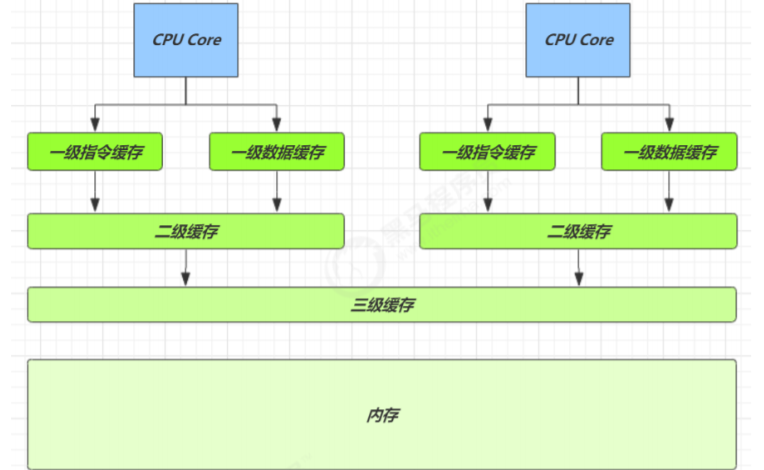
因为 CPU 与 内存的速度差异很大,需要靠预读数据至缓存来提升效率。缓存离cpu越近速度越快。 而缓存以缓存行为单位,每个缓存行对应着一块内存,一般是 64 byte(8 个 long),缓存的加入会造成数据副本的产生,即同一份数据会缓存在不同核心的缓存行中,CPU 要保证数据的一致性,如果某个 CPU 核心更改了数据,其它 CPU 核心对应的整个缓存行必须失效。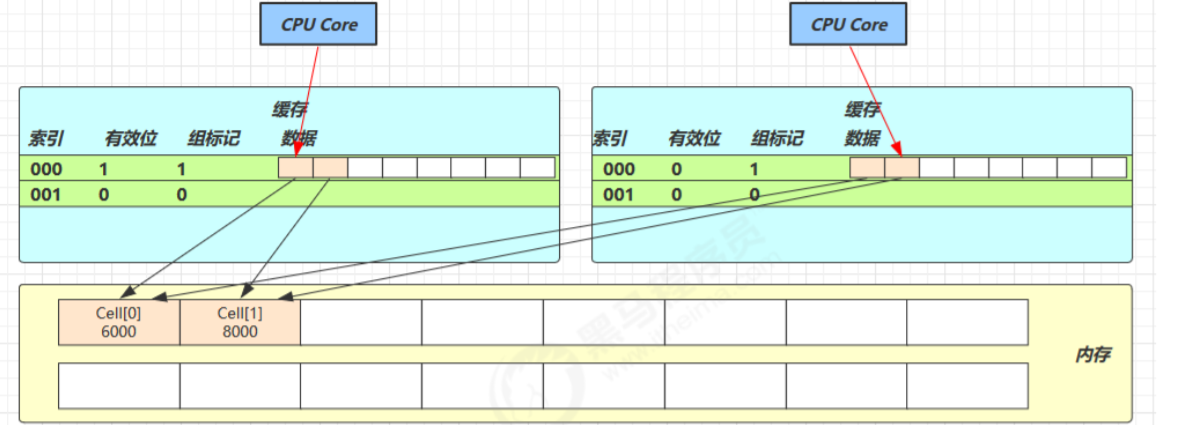
因为 Cell 是数组形式,在内存中是连续存储的,一个 Cell 为 24 字节(16 字节的对象头和 8 字节的 value),因 此缓存行可以存下 2 个的 Cell 对象。这样问题来了: Core-0 要修改 Cell[0],Core-1 要修改 Cell[1]
无论谁修改成功,都会导致对方 Core 的缓存行失效,比如 Core-0 中 Cell[0]=6000, Cell[1]=8000 要累加 Cell[0]=6001, Cell[1]=8000 ,这时会让 Core-1 的缓存行失效,@sun.misc.Contended 用来解决这个问题,它的原理是在使用此注解的对象或字段的前后各增加 128 字节大小的padding,从而让 CPU 将对象预读至缓存时占用不同的缓存行,这样,不会造成对方缓存行的失效
再来看看LongAdder类的累加increment()方法中又主要调用下面的方法
public void add(long x) {
// as 为累加单元数组
// b 为基础值
// x 为累加值
Cell[] as; long b, v; int m; Cell a;
// 进入 if 的两个条件
// 1. as 有值, 表示已经发生过竞争, 进入 if
// 2. cas 给 base 累加时失败了, 表示 base 发生了竞争, 进入 if
if ((as = cells) != null || !casBase(b = base, b + x)) {
// uncontended 表示 cell 没有竞争
boolean uncontended = true;
if (
// as 还没有创建
as == null || (m = as.length - 1) < 0 ||
// 当前线程对应的 cell 还没有被创建,a为当线程的cell
(a = as[getProbe() & m]) == null ||
// 给当前线程的 cell 累加失败 uncontended=false ( a 为当前线程的 cell )
!(uncontended = a.cas(v = a.value, v + x))
) {
// 进入 cell 数组创建、cell 创建的流程
longAccumulate(x, null, uncontended);
}
}
}
add 方法分析
add 流程图
final void longAccumulate(long x, LongBinaryOperator fn,
boolean wasUncontended) {
int h;
// 当前线程还没有对应的 cell, 需要随机生成一个 h 值用来将当前线程绑定到 cell
if ((h = getProbe()) == 0) {
// 初始化 probe
ThreadLocalRandom.current();
// h 对应新的 probe 值, 用来对应 cell
h = getProbe();
wasUncontended = true;
}
// collide 为 true 表示需要扩容
boolean collide = false;
for (;;) {
Cell[] as; Cell a; int n; long v;
// 已经有了 cells
if ((as = cells) != null && (n = as.length) > 0) {
// 但是还没有当前线程对应的 cell
if ((a = as[(n - 1) & h]) == null) {
// 为 cellsBusy 加锁, 创建 cell, cell 的初始累加值为 x
// 成功则 break, 否则继续 continue 循环
if (cellsBusy == 0) { // Try to attach new Cell
Cell r = new Cell(x); // Optimistically create
if (cellsBusy == 0 && casCellsBusy()) {
boolean created = false;
try { // Recheck under lock
Cell[] rs; int m, j;
if ((rs = cells) != null &&
(m = rs.length) > 0 &&
// 判断槽位确实是空的
rs[j = (m - 1) & h] == null) {
rs[j] = r;
created = true;
}
} finally {
cellsBusy = 0;
}
if (created)
break;
continue; // Slot is now non-empty
}
}
// 有竞争, 改变线程对应的 cell 来重试 cas
else if (!wasUncontended)
wasUncontended = true;
// cas 尝试累加, fn 配合 LongAccumulator 不为 null, 配合 LongAdder 为 null
else if (a.cas(v = a.value, ((fn == null) ? v + x : fn.applyAsLong(v, x))))
break;
// 如果 cells 长度已经超过了最大长度, 或者已经扩容, 改变线程对应的 cell 来重试 cas
else if (n >= NCPU || cells != as)
collide = false;
// 确保 collide 为 false 进入此分支, 就不会进入下面的 else if 进行扩容了
else if (!collide)
collide = true;
// 加锁
else if (cellsBusy == 0 && casCellsBusy()) {
// 加锁成功, 扩容
continue;
}
// 改变线程对应的 cell
h = advanceProbe(h);
}
// 还没有 cells, cells==as是指没有其它线程修改cells,as和cells引用相同的对象,使用casCellsBusy()尝试给 cellsBusy 加锁
else if (cellsBusy == 0 && cells == as && casCellsBusy()) {
// 加锁成功, 初始化 cells, 最开始长度为 2, 并填充一个 cell
// 成功则 break;
boolean init = false;
try { // Initialize table
if (cells == as) {
Cell[] rs = new Cell[2];
rs[h & 1] = new Cell(x);
cells = rs;
init = true;
}
} finally {
cellsBusy = 0;
}
if (init)
break;
}
// 上两种情况失败, 尝试给 base 使用casBase累加
else if (casBase(v = base, ((fn == null) ? v + x : fn.applyAsLong(v, x))))
break;
}
}

上图中的第一个else if 中代码的逻辑,这是cells未创建时的处理逻辑。
上图中的if 中代码的逻辑,里面包含线程对应的cell已经创建好和没创建好的两种情况。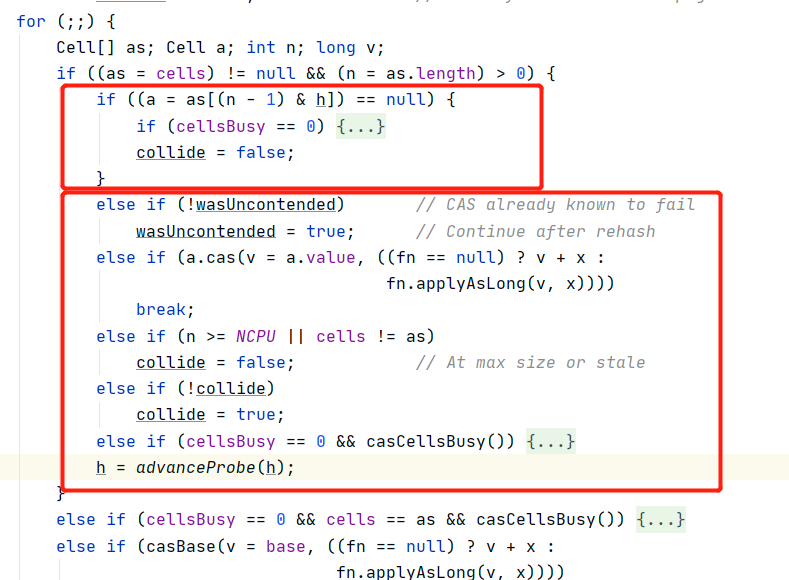
线程对应的cell还没创建好,则执行的是第一个红框里的代码,逻辑如下
线程对应的cell已经创建好,则执行的是第二个红框里的代码,逻辑如下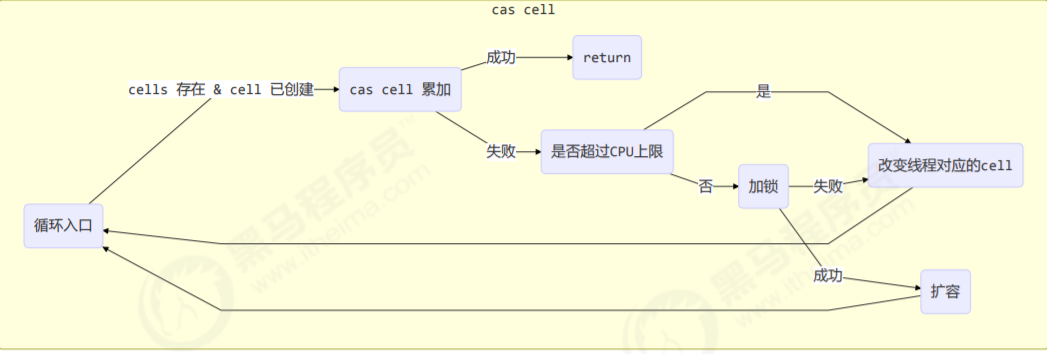
sum 方法分析
获取最终结果通过 sum 方法,将各个累加单元的值加起来就得到了总的结果。
public long sum() {
Cell[] as = cells; Cell a;
long sum = base;
if (as != null) {
for (int i = 0; i < as.length; ++i) {
if ((a = as[i]) != null)
sum += a.value;
}
}
return sum;
}
6.8 Unsafe
概述
Unsafe 对象提供了非常底层的,操作内存、线程的方法,Unsafe 对象不能直接调用,只能通过反射获得。LockSupport的park方法,cas相关的方法底层都是通过Unsafe类来实现的。Test14.java
static Unsafe unsafe;
static {
try {
// Unsafe 使用了单例模式,unsafe对象是类中的一个私有的变量
Field theUnsafe = Unsafe.class.getDeclaredField("theUnsafe");
theUnsafe.setAccessible(true);
unsafe = (Unsafe) theUnsafe.get(null);
} catch (NoSuchFieldException | IllegalAccessException e) {
throw new Error(e);
}
}
static Unsafe getUnsafe() {
return unsafe;
}

